 |
 |
 |
| |
|
Safety, Pharmacokinetics and Antiviral effects of Boehringer Ingelheim BILB 1941, a Novel HCV RNA Polymerase, After 5 days Oral treatment in Patients with Chronic Hepatitis C
|
| |
| |
"BILB 1941 given as monotherapy in a liquid formulation for 5 days demonstrated significant antiviral activity against genotype 1 hepatitis C virus. Increased virologic response was limited by GI intolerance that precluded testing at higher doses. The contribution to the GI side effects by BILB 1941 vs the constituents of the liquid formulation remains uncertain. The reductions in viral load seen with this class of HCV NS5B polymerase inhibitors warrant further investigation."
Reported by Jules Levin
EASL, April 2007, Barcelona, Spain
Erhardt1, H Wedemeyer2, Y Benhamou3, C Mölleken4, X Forns5, S. Pol6, JL Calleja7, S Ross8, HC Spangenberg9, J Garcia-Samaniego10,
M Fuchs11, J Enríquez12, J Wiegand13, J Stern14, K Wu14, G Nehmiz14, J Steffgen14 for the BILB 1941 study group
1Universitatsklinik Dusseldorf, 2Medizinische Hochschule Hannover, 3Groupe Hospitalier Pitié-Salpêtrière Paris, 4Universitatsklinik Bochum, 5Hospital Clinic
6HOP Necker Paris, 7Clinica Puerta de Hierro Madrid, 8Universitatsklinik Kiel, 9Universitatsklinik Freiburg, 10Hospital Carlos III Madrid,
11Universitatsklinik Ulm, 12Hospital de la Santa Creu I Sant Pau Barcelona, 13Universitatsklinik Leipzig, 14Boehringer Ingelheim Ridgefield CT and Biberach
INTRODUCTION
BILB 1941 ZW is a novel, orally bioavailable, and reversible non-nucleoside inhibitor of the RNA-dependent RNA plymerase of the hepatitis C virus. The compound exhibits potent and specific inhibition of the HCV RNA dependent RNA polymerase in anzymatic and cell based assays (EC50=84 for Genotype 1b and 153 nM for GT 1a).
METHODS
The study enrolled 18-65 year old male patients with chronic HCV genotype 1 (Bayer Trugene HCV 5'NC Assay) with minimal to mild liver biopsy (Ishal grade 100,000 IU/mL at screening. Exclusion criteria included co-infection with HIV or HBV, any other or additional cause for chronic liver disease, concurrent disease requiring treatment, use of any co-medication, treatment with interferon and/or ribavirin within 6 months prior to screening and use of any investigational drug 30 days prior to screening or 5 half-lives whichever is longer.
The following lab values at screening led to exclusion: ALT or AST >2.5 X ULN, total bilirubin >1X ULN, alkaline phosphatase >1.5 X ULN, PTT (INR) >3, platelets <100,000/mm3, Hb <10.5 g/dL or WBC <2,000/mm3.
The study was a double-blind, dose escalating, sequential group comparison. In each dose level 8 patients were randomized to active drug and 2 patients to placebo. Patients were treated with 10, 20, 40, 60, 80, 100, 150, 200, 300, and 450 mg BILB 1941 administered every 8 hours over 5 days. BOLB 1941 was given as solution with Tris-water-PEG400 (5%-34%-61%). All patients were followed up after treatment for 10-14 days.
Viral load (VL) was determined by Roche RT-Taqman.
Genotype (GT) 1a and GT 1b subtypes were determined by NS5B sequencing. Treatment response was defined as a reduction of VL by >/= 1 log step at any time-point on treatment.
Results are reported descriptively; quantitative data are displayed as a mean +/- standard deviation. The dependence of treatment response from covariables was investigated by logistic regression.
RESULTS
One patient on 200 mg and 5 patients on 450 mg discontinued treatment with BILB 1941. The dose level of 450 had to be stopped for tolerability reasons.
All demographic and baseline data were uniform across treatment groups. Demographic data and disease characteristics of the n=96 randomized patients are provided in Tables 1 and 2.
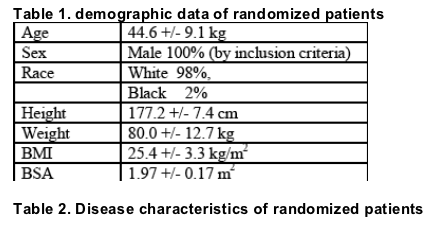
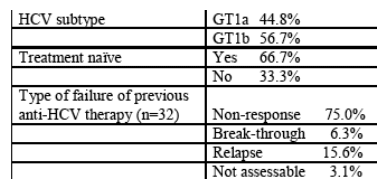
BASELINE VIRAEMIA
Baseline viral load was 6.41 +/-0.56 log10 units.
Natural intra-individual variability between screening and baseline was 0.37 log10 units with an interval length between screening and baseline of 18.9 =/-9.5 days.
Time-Course of VL:
Firgure 1 provides the geometric means of VL normalized to baseline VL for each treatment group during treatment.
Only the group treated with log10 450 mg BILB 1941 ZW showed a >/= 1 log decrease in geometric mean VL at any time-point during the treatment period to day 6.
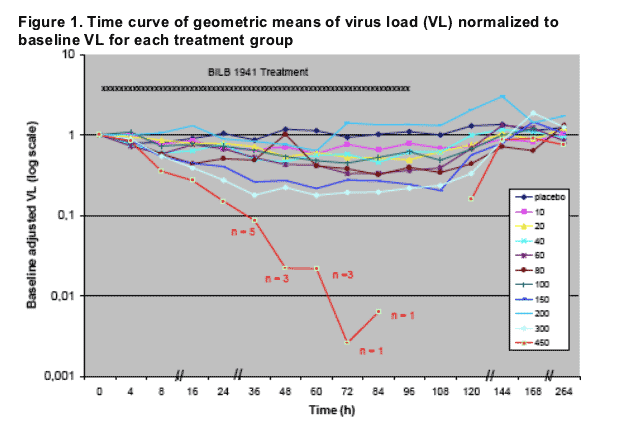
Treatment response by >/= 1 log for all patients and subgenotypes (GT 1a and GT 1b) is shown in Table 3.
A clear trend for a dose response was observed (p=0.0025).
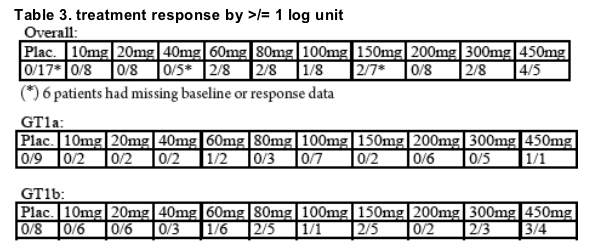
The HCV-subgenotype was of relevant impact on treatment response as only 2/32 patients with GT1a showed a response by >/= 1 log in comparison to 11/41 patients with GT1b (p=0.0086).
In addition to the basic model consisting of log (dose) and HCV subtype, none of the other investigated factors had a significant influence on response. Trends were seen for the following (given as odds ratio [OR]), when investigated on top of log (dose) and HCV subtype but separately from each other:

No difference whatsoever was seen between pre-treated and naïve patients.
PHARMACOKINETICS
Figure 2 shows that the plasma exposure of BILB 1941 exhibited linear pharmacokinetics up to 300 mg, but could not be sufficiently investigated for the 450 mg group due to incompletion.
No clear PK/PD relationship was detected.
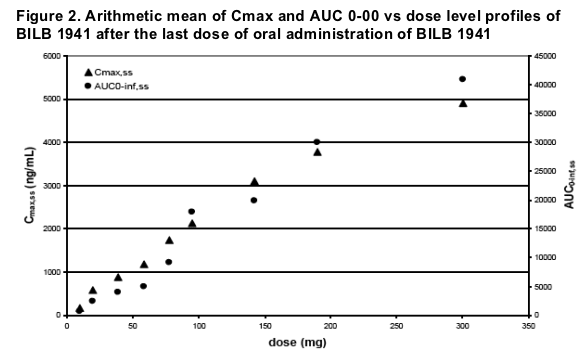
SAFETY
No serious adverse events were reported during this study. The most frequent and most relevant AEs were related to the gastrointestinal (GI) tract. Diarrhea was the most frequent adverse event, being reported in 27 patients. All GI adverse events were reversible.
The frequency of GI adverse events, especially diarrhea, increased in a dose-related manner with doses below 450 mg but did not lead to discontinuation in these groups.
In the 450 mg dose level, only 5 patients were treated with active drug; 4 patients discontinued before day 5 due to GI intolerance (2 due to diarrhea, 1 due to nausea and an increase in bilirubin to 1.8XULN and 1 patient due to abdominal pain in combination with increase in GGT). One patient treated with 450 mg BILB 1941 discontinued due to 2 subsequent increases by >/= 50% in AST and ALT (predefined stopping rule; maximal values were <2X ULN). The 450 mg dose level and the trial as a whole were then discontinued due to increase of AST >3X baseline occurring together with a CK of 3318 after intense sports. However, median changes in transaminases from baseline were not different between all dose groups including placebo during treatment.
On a 4-point scale, tolerability was considered by the investigators as "good" in all patients in dose levels up to 60 mg in 7/8, 7/8, 4/8, 4/8, 6/8 and 0/5 patients treated with 80, 100, 150, 200, 300 and 450 mg BILB 1941, respectively.
CONCLUSION
BILB 1941 given as monotherapy in a liquid formulation for 5 days demonstrated significant antiviral activity against genotype 1 hepatitis C virus. Increased virologic response was limited by GI intolerance that precluded testing at higher doses. The contribution to the GI side effects by BILB 1941 vs the constituents of the liquid formulation remains uncertain. The reductions in viral load seen with this class of HCV NS5B polymerase inhibitors warrant further investigation.
|
| |
|
 |
 |
|
|